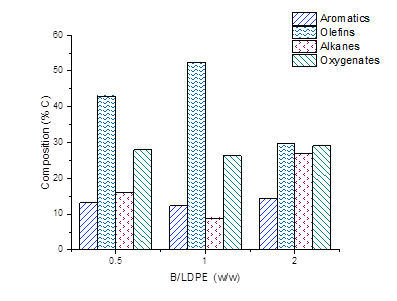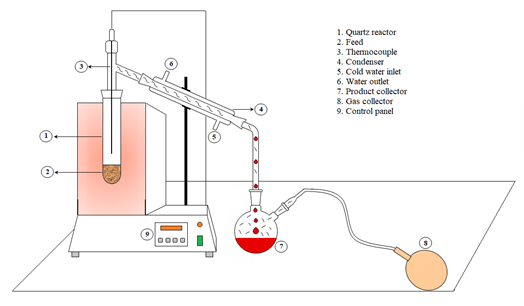(104c) Catalytic Co-Pyrolysis of Biomass and Low-Density Polyethylene with Spent FCC Catalyst
AIChE Spring Meeting and Global Congress on Process Safety
2020
2020 Virtual Spring Meeting and 16th GCPS
Process Development Division
Biomass Conversion to Valuable Products
Thursday, August 20, 2020 - 3:40pm to 4:00pm
polyethylene with spent FCC catalyst
Kanduri Praveen Kumar a,
Seethamraju Srinivas a1
Institute of Technology Bombay, Powai, Mumbai 400076, India. text-align:center;line-height:150%">(
aCorresponding
Author: Department of Energy Science and Engineering, Indian Institute of
Technology Bombay, Powai, Mumbai 400076, India; praveen.k@iitb.ac.in )
Keywords: Biomass, Plastics,
Spent FCC catalyst, Co-pyrolysis, Bio-oil
1. Introduction
justify;line-height:150%">Concernsover the dwindling fossil fuel reserves, rising global energy demand, and the
adverse impact of carbon emissions on the global climate provide an impetus to
utilize biomass as a renewable source of energy [1,2]. Biomass (B) conversion
technologies such as pyrolysis and gasification are some of the pathways to
convert biomass to higher-value products. Of these, pyrolysis offers an
attractive way of transforming the low-energy density biomass into a
high-energy-density liquid called bio-oil. Owing to its heterogeneity, thermal
breakdown of biomass produces chemically different compounds and bio-oil or
pyrolysis-oil has fuel characteristics that are inferior to that of
conventional fuels, mainly due to the presence of oxygenated-compounds in it.
Bio-oil typically contains ~45-50 wt% oxygen and is distributed widely among
more than 300 compounds [3]. These oxygenates impart-high acidity, low heating
value, high viscosity, and instability to bio-oil [4]. Therefore, the removal
of these reactive oxygenates and improving the bio-oil quality is essential for
its acceptance as a fuel. justify;line-height:150%"> justify;line-height:150%">Catalytic
cracking is one of the many upgrading techniques to achieve this goal. However,
the major drawbacks associated with the process are high char formation, low
hydrocarbon yield, and short catalyst lifetime [5]. Although catalyst helps to
reduce the oxygen content in bio-oil through mechanisms of dehydration,
decarbonylation and decarboxylation, the char produced by pyrolysis reactions
rapidly deactivates it. The char formation is mostly the consequence of low
hydrogen-environment during pyrolysis processes, as biomass is a carbon-rich
and hydrogen-deficient species. Plastics like LDPE (Low-density polyethylene) are
hydrogen-rich materials [(H/C) ratio of ~2] and their utilization in pyrolysis
as a co-reactant significantly improves the hydrocarbon yield, and reduces the
extent of char formation. The current research focuses on the conversion of
biomass to compounds of high value in the petrochemical industry. Olefins and
aromatics, including benzene, toluene, and xylene are the most desired compounds
in the petrochemical industry – these are the starting materials for
manufacturing a wide range of specialty chemicals. justify;line-height:150%"> justify;line-height:150%">Spent
FCC is a waste from petroleum refineries and is generally disposed of in
landfills. Though considered as a waste, it can be used in co-pyrolysis
processes to convert the biomass volatiles to more valuable compounds
particularly, aromatics. This study therefore investigates the high-value
utilization of low-value materials (waste biomass, waste plastics, and spent
FCC). justify;line-height:150%"> justify;line-height:150%">2.
Methodology
In this study,
catalytic co-pyrolysis (CCP) of mixtures of biomass (groundnut shell) and
plastics (LDPE) with spent FCC were performed (see Fig.1) to investigate the
potential of spent FCC as a catalyst to produce aromatic hydrocarbons and to
study the effect of feed composition on the pyrolysis products. The experiments
were conducted at 510°C in both in-situ and ex-situ modes with 30
g of feed, 10% w/w catalyst loading, and at three different biomass to plastic
ratios (1:1, 1:2, and 2:1). The pyrolysis-oil was analyzed using a GC-MS and the
pyrolysis gases were analyzed offline using a Gas chromatograph equipped with a
thermal conductivity detector. The results were compared in terms of % carbon
yield of pyrolysis products (aromatics, olefins, alkanes, and oxygenates).
catalytic co-pyrolysis experimental set-up 150%"> 150%">3.
Results and Discussion justify;line-height:150%">Fig.
2 summarizes the product distribution for in-situ CCP of biomass and
LDPE as a function of feed ratio; similar plots were obtained for ex-situ
experiments too. In both the modes, the liquid yield was maximum at higher LDPE
(plastic) fractions in the feed – ~36 wt% for ex-situ, and ~34 wt% for in-situ
mode. However, the aromatic yield in ex-situ mode was relatively higher
than that of in-situ mode in all cases for the same feed ratios. While the
aromatic yields for ex-situ mode were in the range of ~25-41 %C, and the
peak value was observed at B/LDPE ratio of 1, the corresponding values for the in-situ
mode were ~12-14 %C, and B/LDPE ratio of 2, respectively (see Fig. 2). The ex-situ
mode of CCP was more efficient than the in-situ mode in minimizing the oxygenate
content in the pyrolysis liquid. The oxygenate fraction increased with an
increase in the biomass portion in the feed. The yield of oxygenates for ex-situ
mode varied from ~14-18 %C, with a minimum value at the B/LDPE ratio of 0.5, -
the corresponding values for the in-situ mode are ~26-30 %C at B/LDPE
ratio of 1. text-align:center;line-height:150%">
 text-align:center;line-height:150%">
line-height:150%;font-family:" times new roman>Fig. 2: Bio-oil composition
text-align:center;line-height:150%">
line-height:150%;font-family:" times new roman>Fig. 2: Bio-oil compositionas a function of feed ratio for in-situ CCP of biomass and LDPE mixtures justify;line-height:150%"> justify;line-height:150%">These
results suggest that the product distribution in CCP is a strong function of
pyrolysis configuration (in-situ or ex-situ) and feed
composition. The ex-situ mode CCP enhanced the quality of pyrolysis
liquid, especially the mono-aromatics selectivity, when compared to the liquid
from in-situ CCP. The significant advantage of using ex-situ
configuration is the ease of catalyst recovery which is laborious in case of
the in-situ method. The spent FCC catalyst in both the configurations was
effective in deoxygenating the biomass through dehydration, decarbonylation,
and decarboxylation mechanisms. Therefore, the secondary use of this catalyst in
pyrolysis will help in deriving the energy from waste biomass and plastics and
also reduce the costs involved in the development and purchase of fresh or
proprietary catalysts. Future work is in progress to study the effect of HDPE
in CCP owing to its difference in crystallinity and thermal degradation
compared to LDPE. line-height:150%"> text-align:justify;line-height:150%"> " times new roman>References margin-left:14.2pt;margin-bottom:.0001pt;text-align:justify;text-indent:-14.2pt;
line-height:150%">1. Dinesh Mohan, Charles
U. Pittman, Jr., Philip H. Steele, Pyrolysis of Wood/Biomass for Bio-oil: A
Critical Review, Energy Fuel, 20 (2006), pp. 848-889 0cm;margin-left:14.2pt;margin-bottom:.0001pt;text-align:justify;text-indent:
-14.2pt;line-height:150%">2. George W. Huber, Sara
Iborra, Avelino Corma, Synthesis of Transportation Fuels from Biomass:
Chemistry, Catalysts, and Engineering, Chem. Rev., 106 (2006), pp. 4044-4098 0cm;margin-left:14.2pt;margin-bottom:.0001pt;text-align:justify;text-indent:
-14.2pt;line-height:150%">3. A.V. Bridgwater,
Review of fast pyrolysis of biomass and product upgrading, Biomass Bioenergy,
38 (2012), pp. 68-94 0cm;margin-left:14.2pt;margin-bottom:.0001pt;text-align:justify;text-indent:
-14.2pt;line-height:150%">4. David Martin Alonso,
Jesse Q. Bond, James A. Dumesic, Catalytic conversion of biomass to biofuels, Green
Chem., 12 (2010), pp. 1493–1513 0cm;margin-left:14.2pt;margin-bottom:.0001pt;text-align:justify;text-indent:
-14.2pt;line-height:150%">5. Xiangyu Li, Jian Li, Guoqiang
Zhou, Yu Feng, Yujue Wang, Gang Yu, Shubo Deng, Jun Huang, Bin Wang, Enhancing
the production of renewable petrochemicals by co-feeding of biomass with
plastics in catalytic fast pyrolysis with ZSM-5 zeolites, Appl. Catal., A, 481
(2014), pp. 173–182
Checkout
This paper has an Extended Abstract file available; you must purchase the conference proceedings to access it.
Do you already own this?
Log In for instructions on accessing this content.
Pricing
Individuals
| AIChE Pro Members | $150.00 |
| Employees of CCPS Member Companies | $150.00 |
| AIChE Graduate Student Members | Free |
| AIChE Undergraduate Student Members | Free |
| AIChE Explorer Members | $225.00 |
| Non-Members | $225.00 |

